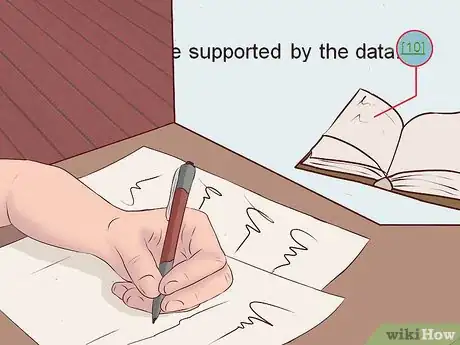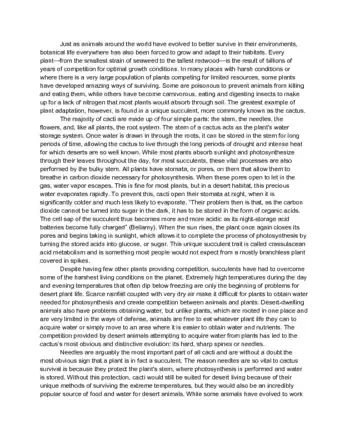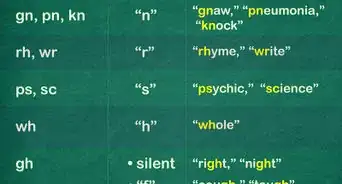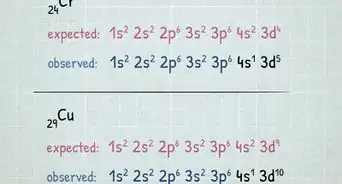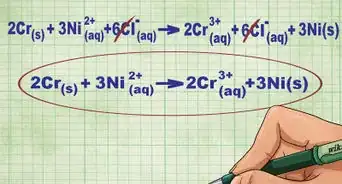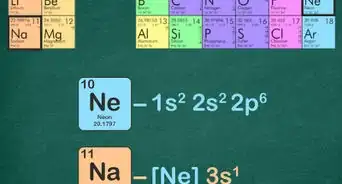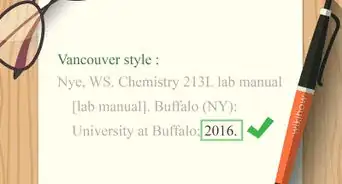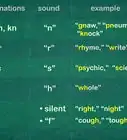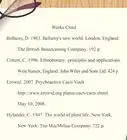This article was co-authored by Bess Ruff, MA. Bess Ruff is a Geography PhD student at Florida State University. She received her MA in Environmental Science and Management from the University of California, Santa Barbara in 2016. She has conducted survey work for marine spatial planning projects in the Caribbean and provided research support as a graduate fellow for the Sustainable Fisheries Group.
There are 7 references cited in this article, which can be found at the bottom of the page.
wikiHow marks an article as reader-approved once it receives enough positive feedback. In this case, 94% of readers who voted found the article helpful, earning it our reader-approved status.
This article has been viewed 107,966 times.
Even if you are not planning to publish a scientific paper, you may be asked to write in this format for a college course or other program. Because scientific papers are written in a specific format, it is both easy and necessary to learn how to write them well. Following the style guide and knowing the necessary content of each section will help you to develop your skills as a scientific writer.
Steps
Formatting the Paper
-
1Know your audience. If you are in a field that crosses disciplines you might need to write the paper a bit differently than if you were aiming the information at one field. In some cases, you may want your study to be accessible to all readers, so you need to write the paper in a way that everyone will understand. In other cases, the audience may be people in the same field that have background knowledge of the subject.
- Since it is a technical paper, you will need to use some technical language, but avoid jargon for the sake of jargon and use acronyms only when absolutely necessary.[1]
- Define all acronyms the first time you use the full word or phrase, then use the acronym throughout the rest of the paper.
-
2Use active voice. For the most part, journals will require you to use active voice. This is not the case for every journal so make sure to check the style guide before you start writing. To use active voice, write statements like “We performed this experiment…” instead of “The experiment was performed…”[2]Advertisement
-
3Follow the style guide for publication. If you are submitting the paper to a journal for publication, they will have a style guide or author guide that details all of the necessary formatting. It will tell you the maximum word count, the margin size, the font size/style, references format, etc. Following the author guide is absolutely necessary when submitting the paper for publication.
- Any restrictions on table/figure sizes or table/figure legends will also be included in the style guide.
-
4Organize the paper in the proper order. Every scientific paper is structured the same way. It starts with an abstract that briefly summarizes the paper and then leads into an introduction. The materials and methods come next, followed by the results. The paper concludes with the discussion section and a list of references.[3]
- Some journals move the materials and methods to the end of the paper and/or combine the results with the discussion section. Check the style guide for the specific journal you are submitting to.
- Although this is the order the paper will be published in, it is not necessarily the best order to write each section. Follow the steps in the “Writing the Sections” for the best way to compose the paper.[4]
Writing the Sections
-
1Start with the Materials and Methods section. When you sit down to write your scientific paper, the first section you want to write is the materials and methods section. It is the easiest place to start and doesn’t require much time to complete. The methods should be described clearly and anyone with the proper training should be able to replicate your experiments based on this section.[5]
- Materials used for each method should be included, with references to the company and catalog number for purchase.
- You should include a description of all statistical methods used in the paper.
- You should also include explanations of any ethical approvals needed for the completion of the studies.
-
2Describe the results in the Results section. The results section is pretty self-explanatory. It is the portion of the paper where you describe the results that were obtained during the course of the study. Results should be reported neutrally and reference any tables and figures included in the paper.[6] You can summarize the findings, but do not discuss the data.[7]
- You don’t need to include every experiment you performed or result you observed, just the information needed to convince the audience of your findings.[8]
- This is not the section to speculate or draw conclusions. That comes later in the discussion.
-
3Interpret your data in the Discussion section. This is where you interpret your results and discuss them in the context of what is already known about your topic. Draw conclusions about the data and talk about future experiments you would like to do to further the study. The goal is to convince the reader that this data is important and they should care about it. Avoid simply repeating what you have already said in the results section.[9]
- Avoid making wild claims that can’t be supported by the data.[10]
- Don’t ignore other papers that contradict your findings; discuss them and convince the reader why your data is correct despite the other information out there.
- Some journals combine the results and discussion into 1 larger section. Check with the journal before you begin writing.[11]
-
4Review the literature in the Introduction. The introduction is where you convince readers that the study you have done is important and tell them why it is important. This section should thoroughly review the available literature, discussing the problem, its significance, existing solutions, and the gap your work is trying to fill.[12]
- State your hypothesis and objectives at the end of the introduction.[13]
- Avoid long introductions; you want to be comprehensive, but succinct.
-
5Summarize the paper in the Abstract. Save the abstract until the rest of the paper is complete. The length of this section is usually dependent upon the journal, but is generally around 250 words. It is a short summary to tell the readers what you did and what the important findings were. The final sentence should offer some interpretation/conclusion about the findings.[14]
- Think of the abstract as an advertisement to encourage people to keep reading.
-
6Write a descriptive Title. The final aspect of the paper to complete is to write the title. You want the title to be specific and reflect the data that is presented in the paper. This is the teaser for the paper, so you want to grab their attention. At the same time, you want to be succinct and use as few words as possible.[15]
- Avoid technical jargon and abbreviations/acronyms.
- Consider which keywords you want to tag so that readers searching for articles on a specific topic will be directed to your work.
Making the Figures and Tables
-
1Choose to present the data as a figure or a table. The way you present the data is completely up to you, but there are some guidelines to help you decide the best way to show it to readers. Tables are used to present the raw data of the experiment while figures are used to illustrate comparisons.[16] If the data can easily be stated in 1-2 sentences, there is no need for a figure or a table.[17]
- Tables are frequently used to provide information about the makeup of a study group or the concentrations used within a study.
- Figures are used to compare the experimental results of the different groups in a visual way.
-
2Format the table properly. When presenting data in a table, you must align any decimal points in numbers. Tables include short self-explanatory titles and brief legends to explain acronyms.[18]
- Don’t include tables if they are not referenced in the text. You can add these tables to an appendix if absolutely necessary.
- Position the legend directly above the table.
-
3Make data sets easily distinguishable. When constructing a figure, avoid adding too many datasets to one graph. This will look cluttered and will be difficult for the reader to understand. You may need to split the data into multiple graphs.[19] This does not change the way the data is analyzed or interpreted, it just makes it easier to see.
- Avoid adding more than 3-4 datasets per graph.
- Label all axes properly and use the appropriate scales.
-
4Include scale markers on photographs. When using microscope images or photographs of specimens, a scale bar must be included so the reader understands the size of what they are looking at. Make the scale bar clear, the font size easily readable, and include it in the corner of the image.[20]
- If the image is dark, make the scale bar white. If the image is light, make the scale bar a contrasting dark. If the reader can’t see the scale bar, it is not useful.
-
5Use black and white images whenever possible. If the paper is for a course, this step doesn’t necessarily apply. If you are submitting to a journal, there are substantial fees associated with color images, so avoid using colored figures if you can use line styles or patterned graphs instead.[21]
- If you do use color, use complementary mute colors that don’t scream off the page.
-
6Use fonts that are large enough to read. When making the figure, the font may look perfectly legible, but keep in mind it will be smaller when placed into the paper itself. Before you turn the paper in, look through all of the figures and make sure that all of the text is readable without having to squint.[22]
-
7Write figure legends that describe the data. The figure legend shouldn’t be too long, but should give enough information to the reader for them to interpret the data without reading the corresponding text in the paper.[23] Spell out any acronyms used.
- The figure legend should be positioned underneath the figure itself.
Citing Your Sources Properly
-
1Use inline citations. Every source should be cited directly within the paper. If you are making a statement based on information read in a book or another journal article, it needs to be cited directly after the statement.[24] If you have multiple references that support one fact, cite all of them. Keep in mind, more citations doesn’t make a better paper.
- Cite peer-reviewed literature, manuscripts, and published data.
- Avoid personal communications, submitted, but unpublished manuscripts, and articles not in English.[25]
-
2Check the style guide for format. If you are submitting the paper for publication, the journal you are submitting to will have a specific style guide that will detail the format of inline citations and the reference list at the end. If the paper is for a course, ask your professor for the format.[26]
- Some journals use an inline citation of (Author, Publication Year) with an alphabetical list at the end. Other journals simply use superscript numbers within the paper and have the numbered list of references at the end.[27]
-
3Match the content to the source. Make sure the source you are using accurately reflects the information you are saying. If the source doesn’t support your statement, find a different source.
- Paraphrase the source and avoid direct quotes. If you must quote directly, put the information in quotation marks and specify the page the quote came from.[28]
-
4Avoid citing “common knowledge.” Many journals have a limit on the number of citations that can be used in a paper. You want your paper to be well-cited, but if you have a limit, you want to make sure you are citing important information that supports your conclusions. If you’re unsure about information, err on the side of caution and cite it.
- If something is considered to be common knowledge in the field, it is not necessary to cite it. For example, stating that DNA is the genetic material of an organism does not need a citation.
-
5Use citation programs. The easiest way to compile all of your references is to use a software program such as Endnote or Mendeley. These programs organize the references within the paper and make sure the format is correct. Many journals have a citation format that you can download and import into the reference manager that will update all of your references to the format required for that journal.[29]
- Reference managers help avoid incorrect citations and save you hours of work updating the list of citations individually as you go.
- For more information on citation programs, check out https://subjectguides.library.american.edu/c.php?g=175008&p=3205957.
Sample Paper
References
- ↑ http://www.scidev.net/global/publishing/practical-guide/how-do-i-write-a-scientific-paper-.html
- ↑ http://www.scidev.net/global/publishing/practical-guide/how-do-i-write-a-scientific-paper-.html
- ↑ http://www.ncbi.nlm.nih.gov/pmc/articles/PMC3474301/
- ↑ https://www.elsevier.com/connect/11-steps-to-structuring-a-science-paper-editors-will-take-seriously#step4
- ↑ http://www.ncbi.nlm.nih.gov/pmc/articles/PMC3474301/
- ↑ http://www.ncbi.nlm.nih.gov/pmc/articles/PMC3474301/
- ↑ http://www.columbia.edu/cu/biology/ug/research/paper.html
- ↑ http://www.nature.com/scitable/ebooks/english-communication-for-scientists-14053993/118519636#headerAndCitation
- ↑ http://www.scidev.net/global/publishing/practical-guide/how-do-i-write-a-scientific-paper-.html
- ↑ https://www.elsevier.com/connect/11-steps-to-structuring-a-science-paper-editors-will-take-seriously#step4
- ↑ http://www.ncbi.nlm.nih.gov/pmc/articles/PMC3474301/
- ↑ http://www.ncbi.nlm.nih.gov/pmc/articles/PMC3474301/
- ↑ https://www.elsevier.com/connect/11-steps-to-structuring-a-science-paper-editors-will-take-seriously#step4
- ↑ https://www.elsevier.com/connect/11-steps-to-structuring-a-science-paper-editors-will-take-seriously#step4
- ↑ https://www.elsevier.com/connect/11-steps-to-structuring-a-science-paper-editors-will-take-seriously#step4
- ↑ https://www.elsevier.com/connect/11-steps-to-structuring-a-science-paper-editors-will-take-seriously#step11
- ↑ http://www.scidev.net/global/publishing/practical-guide/how-do-i-write-a-scientific-paper-.html
- ↑ http://www.scidev.net/global/publishing/practical-guide/how-do-i-write-a-scientific-paper-.html
- ↑ https://www.elsevier.com/connect/11-steps-to-structuring-a-science-paper-editors-will-take-seriously#step11
- ↑ https://www.elsevier.com/connect/11-steps-to-structuring-a-science-paper-editors-will-take-seriously#step11
- ↑ https://www.elsevier.com/connect/11-steps-to-structuring-a-science-paper-editors-will-take-seriously#step11
- ↑ https://www.elsevier.com/connect/11-steps-to-structuring-a-science-paper-editors-will-take-seriously#step11
- ↑ http://www.scidev.net/global/publishing/practical-guide/how-do-i-write-a-scientific-paper-.html
- ↑ http://www.scidev.net/global/publishing/practical-guide/how-do-i-write-a-scientific-paper-.html
- ↑ https://www.elsevier.com/connect/11-steps-to-structuring-a-science-paper-editors-will-take-seriously#step11
- ↑ http://abacus.bates.edu/~ganderso/biology/resources/writing/HTWcitations.html
- ↑ http://www.scidev.net/global/publishing/practical-guide/how-do-i-write-a-scientific-paper-.html
- ↑ http://www.scidev.net/global/publishing/practical-guide/how-do-i-write-a-scientific-paper-.html
- ↑ https://www.elsevier.com/connect/11-steps-to-structuring-a-science-paper-editors-will-take-seriously#step11
About This Article
To write a scientific paper, start with an abstract that briefly summarizes the paper and leads into your introduction. In the introduction, review the available literature on your topic, and discuss the gap your work is trying to fill. At the end of the introduction, clearly state your hypothesis and objectives. Next, list your materials and methods, followed by your results. Then, conclude your paper with a discussion section and a list of references. To learn how to write the abstract for your paper, keep reading!

















